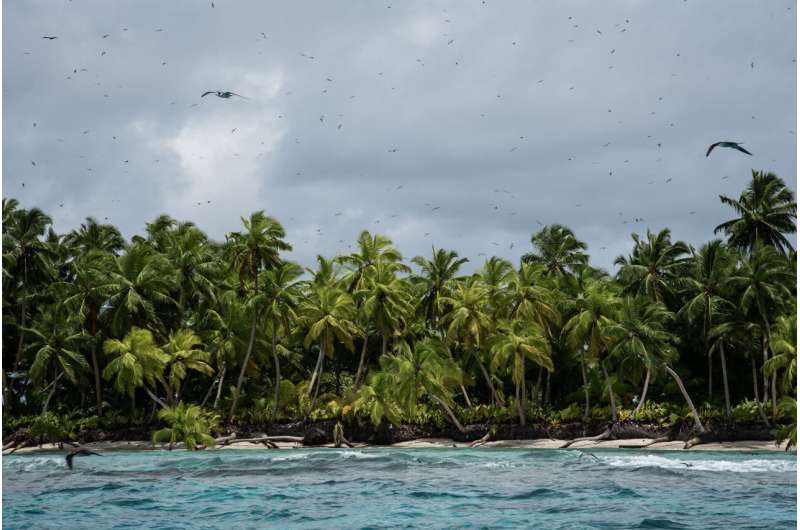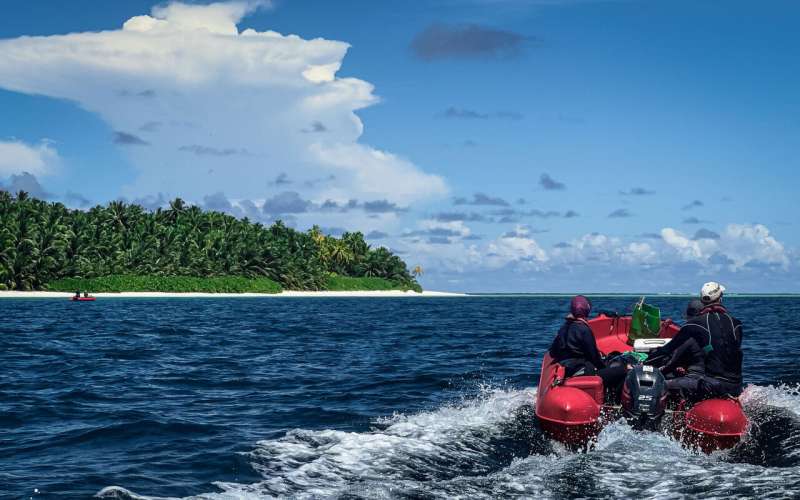This article has been reviewed according to Science X's editorial process and policies. Editors have highlighted the following attributes while ensuring the content's credibility:
fact-checked
peer-reviewed publication
trusted source
proofread
Restored rat-free islands could support hundreds of thousands more breeding seabirds

Hundreds of thousands more breeding pairs of seabirds could return to remote island archipelagos if invasive rats were removed and native vegetation restored, a new paper finds.
In a first-of-its-kind study, researchers also calculated that surrounding the targeted remote tropical islands, there are enough fish in the seas within the hunting range of seabirds to support these restored populations.
This is an important factor that has not been considered in previous island restoration studies and could become a vital consideration to guide future island restoration projects around the world, researchers behind the study say.
The findings by an international team of marine scientists, led by researchers at Lancaster University, have been published today in the journal Conservation Biology.
"We know that invasive species, such as rats, have devastating impacts on native seabird populations—they eat the eggs, chicks and even sometimes adult birds," said Dr. Ruth Dunn of Lancaster University and lead author of the study.
"It's been shown that restoration projects that remove invasive species, such as rats, are effective. However, when there are limited resources in planning island restoration projects, it is also important to know if seabird populations are restored that there will be enough fish in the sea for them to hunt and eat—especially as threats such as overfishing and climate change make fish populations more uncertain.
"Our study was the first to factor in this important consideration, and encouragingly for the remote islands we studied, we found that there are enough fish in the sea for restored populations of seabirds."
The researchers calculated the energy requirements of restored seabird populations and prey fish quantities using available data. The seas surrounding the remote Chagos Archipelago in the Indian Ocean, the focus of the study, include areas of nature reserves where fishing is restricted. These protected areas may have affected the availability of prey fish for restored seabird populations, the scientists say.
"We hope our findings will be an important case study to guide island restoration projects elsewhere, including potentially the consideration of marine protected areas that limit fishing as part of these projects," said Dr. Dunn.
The research team looked at three projected scenarios where invasive rats would be eradicated from 25 islands, and natural habitat, such as native forest and savannah, would be restored to different degrees.
Their modeling shows that if rats were removed from these 25 islands, that could result in populations of lesser noddies, sooty terns and red-footed boobies recovering to nearly 24,000 breeding pairs—an 18-fold increase.

If native vegetation were restored to half of the surface area of these islands, then breeding pairs on these rat-eradicated islands could achieve 83,000 pairs. And if vegetation were restored to three-quarters of these islands' surface area, then that could lead to more than 280,000 breeding pairs of lesser noddies, sooty terns and red-footed boobies.
The benefits are not limited to what can be seen on the islands. Previous studies by the research team have shown that seabirds play a critical role in cycling nutrients from the deep ocean onto islands, and then onto adjacent coral reefs surrounding the islands.
The seabirds' droppings, known as guano, carry nitrogen and phosphorus, important nutrients that leach into the surrounding seas, fertilizing surrounding coral reef environments.
"Removing invasive predators is vitally important for seabirds to thrive in these tropical island environments, but we also know from previous studies that when we have more seabirds we see positive impacts for coral reefs in the seas surrounding tropical islands," said Dr. Dunn.
The researchers found that the increase in seabird numbers would equate to nitrogen input from seabird droppings increasing from 78 tons a year to 170 tons a year.
This would provide a huge boost to life under the waves, with a 52% increase in fish biomass on the reefs—that equates to around 50,000 tons more reef fish around the islands.
In addition, the scientists predict that under these restored conditions there would also be a significant increase in the number of grazing fish, such as parrotfish, doing important jobs such as eating algae and removing dead coral. These roles are critical in helping reefs recover from disturbances such as storms and bleaching events.
"These findings underscore the substantial role island restoration can have not just in bolstering vulnerable seabird populations, but also in enhancing the resilience of adjacent coral reefs to the impacts of climate change," said Professor Nick Graham of Lancaster University, a co-author of the study.
The marine scientists behind the study say their findings are an important case study to show it is important to consider the wider context when planning resources for island restoration projects. By modeling the impacts of different levels of native vegetation restoration, and available levels of food in surrounding seas, restoration projects can help ensure the best returns for nature.
The research is detailed in the paper "Island restoration to rebuild seabird populations and amplify coral reef functioning."
The paper's authors are Dr. Ruth Dunn, Dr. Cassandra Benkwitt and Professor Nick Graham of Lancaster University; Dr. Olivier Maury and Nicholas Barrier from the Université de Montpellier, and Dr. Peter Carr of the Chagos Conservation Trust.
More information: Island restoration to rebuild seabird populations and amplify coral reef functioning, Conservation Biology (2024). DOI: 10.1111/cobi.14313
Journal information: Conservation Biology
Provided by Lancaster University



















